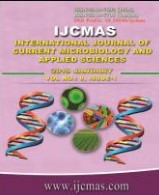


 National Academy of Agricultural Sciences (NAAS)
National Academy of Agricultural Sciences (NAAS)

|
PRINT ISSN : 2319-7692
Online ISSN : 2319-7706 Issues : 12 per year Publisher : Excellent Publishers Email : editorijcmas@gmail.com / submit@ijcmas.com Editor-in-chief: Dr.M.Prakash Index Copernicus ICV 2018: 95.39 NAAS RATING 2020: 5.38 |
Poly house experiment was carried out at Zonal Agricultural and Horticultural Research Station (ZAHRS), Navile, Shivamogga during kharif2016 to study the response of tomato fruit to different sources and levels of calcium. Three sources of calcium [CaCl2, CaNO3 and calcium ammonium nitrate (CAN)] with three levels each (0.20, 0.50 and 0.80%) were applied as a foliar spray in a Complete Randomized Design (CRD) with three replications and ten treatments. The results of experiment indicated that foliar application of calcium through different sources increased the yield of tomato significantly over the control (water spray) due to more uptake and utilization of nutrients from the soil after harvesting of tomato crop. The least nutrient status was recorded (164.34 kg ha-1, 38.49kg ha-1, 255.84kg ha-1, 5.30meq 100g-1, 2.57meq 100g-1, 3.72ppm, 10.32ppm, 1.96ppm, 6.97ppm and 1.94 ppm, respectively) in treatment receiving 0.5 per cent CAN as foliar spray (T9) followed by foliar spray of 0.5 % CAN compared to control, it has recorded highest nutrient status in soil. The correlation study indicates the relationship between calcium nutrition with growth; yield and fruit quality parameters were positively and significantly correlated.
 |
 |
 |
 |
 |